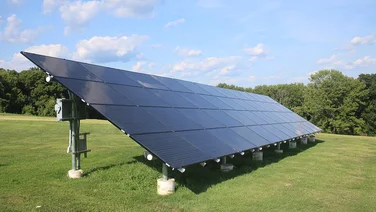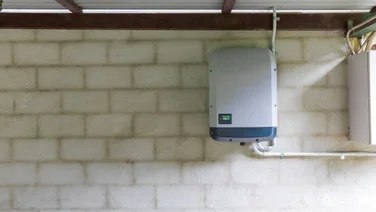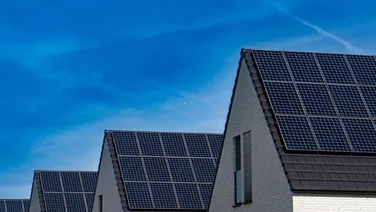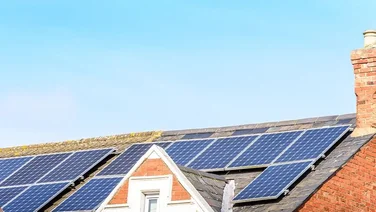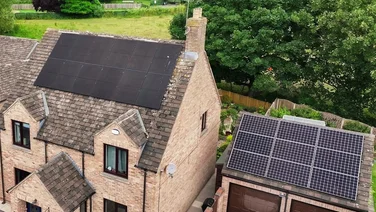✔ Organic solar cells are made of carbon-based molecules or polymers
✔ They are lightweight, flexible, and semi-transparent
✔ Researchers have made organic solar cells that reach 19.3% efficiency
Organic solar cells are an exciting new solar technology and new type of solar cell, so when they hit the wider market they might bring the price of solar panels down even further.
We’ll go over exactly what organic solar cells are, how they work, and what they can be used for in this article. We’ll also let you know who sells them, how much they cost, and what you can expect from organic photovoltaics in the future.

What are organic photovoltaics?
Organic photovoltaic (OPV) cells, or ‘organic solar cells’, are a type of solar cell that use organic semiconductor materials to generate electricity from sunlight.
Organic semiconductors are typically made of carbon-based polymers (large molecules) or small molecules.
This leads to flexible and semi-transparent solar cells, which can be used to create thin-film solar panels, or even transparent solar panels.
For context, traditional solar panels use crystalline silicon as their electricity absorbing material. Silicon solar cells are rigid, and so are used in rigid types of solar panels, such as monocrystalline or polycrystalline panels.
How do organic photovoltaics work?
Organic photovoltaics work the same way solar cells do, by converting sunlight into electricity at an atomic level.
The organic solar cells absorb sunlight in the form of photons (a small particle of electromagnetic energy). The photons knock electrons free from atoms, and their movement creates an electrical current.
When it comes to generating electricity, the only difference between organic solar cells and silicon cells is their semiconducting material.
How efficient are organic photovoltaics?
Older versions of organic photovoltaic cells were 11% efficient on average.
However, in the past few years, researchers have managed to develop organic solar cells that can reach 19.3% efficiency.
That’s still a lower level of efficiency than monocrystalline solar cells, which can reach 24% efficiency. But this innovation means that organic solar cells have the potential to be more efficient than silicon-based thin-film solar panels, which are 7% to 13% efficient.
However, these highly efficient organic solar cells aren’t yet being manufactured on a large scale.
Additionally, one remaining issue is that organic solar cells degrade faster than inorganic silicon-based ones – they last less than 10 years at best, according to The National Renewable Energy Laboratory.
By comparison, traditional solar panels last 25 to 30 years, essentially triple the lifespan of organic solar cells.
The pros and cons of organic photovoltaics
- Flexible cells with versatile applications
- Low manufacturing costs
- Abundance of manufacturing materials
- Low efficiency compared to other solar cell types
- Short lifespan
The advantages of organic photovoltaic cells is that they are lightweight, flexible, and semi-transparent. This means they have a wide breadth of applications, from extremely flexible solar panels, to solar windows or glass.
They also don’t cost as much to manufacture as traditional solar panels. The organic cells are soluble, and can be rolled or vacuum deposited onto a flexible base on a conveyor belt. In traditional solar panels, the cells need to be assembled into a mosaic, slowing down the manufacturing process.
Plus, organic solar cells are made from materials that are easy to obtain, which means they’re less at risk of supply shortages that can push up prices.
The key disadvantages of organic photovoltaic cells are that they are still less efficient than silicon solar cells, and they have a much shorter lifespan. Their short lifespan in particular means that they’re not yet good candidates for long-term, large scale projects.

Are organic photovoltaics commercially available?
Organic solar cells aren’t yet commercially available, although a small number of manufacturers do produce them and are using them in pilot projects.
Heliatek, Nanoflex, and Sunew are three companies that manufacture organic solar cell film, which can be applied to building facades or glass. These companies are marketing their products for use in commercial or public buildings.
Epishine and Dracula Technologies produce small, printed organic solar cells that can work inside the home. They’re designed to power small home devices, such as remote controls.
Most of these companies, however, aren’t yet selling their products to the wider public. It will be a few years yet before organic solar cells become widely available.
How much will organic photovoltaics cost?
Organic photovoltaic panels cost somewhere between £40 and £150 per square metre.
However, it’s very hard to be certain of this range, since mass production is in its very early stages.
In the interest of comparison, silicon solar panels cost around £350 per square metre, but this figure also includes installation costs.
The bottom line is that since organic solar cells cost less to manufacturers than silicon solar cells, it makes sense that they’ll cost less to buy.
What’s the future of organic photovoltaics?
More research and development needs to be done in the future to make organic photovoltaic cells more efficient and longer lasting than current versions.
Researchers have already managed to create organic solar cells that reach 19.3% efficiency. This makes them more efficient than the types of thin-film solar panels or transparent solar panels currently in use today, and we can expect further innovations.
All this is good news, since organic solar cells are the perfect cell type for use in flexible and transparent panels.
Fixing issues with stability and efficiency is a crucial step in getting organic photovoltaic cells into the wider market, and used in large scale solar projects.
Organic photovoltaics: FAQs
What’s the difference between organic solar cells and regular solar cells?
The difference between organic solar cells and regular solar cells is the material they use for converting sunlight into electricity.
Traditional solar cells – the ones used in most commercially available solar panels – use crystalline silicon as a sunlight absorbing component. Organic solar cells use carbon-based polymers or small molecules.
What advantages do organic solar cells have?
Organic solar cells have the advantage of being lightweight, flexible, and semi-transparent. This means they have a wide use of applications, from ultra-flexible solar panels to solar windows.
They are also cheaper to manufacture than traditional silicon solar cells, and are made from more readily available materials, reducing the risk of supply shortages.
Can organic solar cells be recycled?
Organic solar cells can be recycled, but this depends on the type of substrate (a base material for the cells) they are used with.
Organic solar cells that have substrate made from cellulose nanocrystal (CNC), a biodegradable material made from plants, can be easily dissolved in water. Other substrates, made from glass or plastic, make it much harder to recycle the cells.


